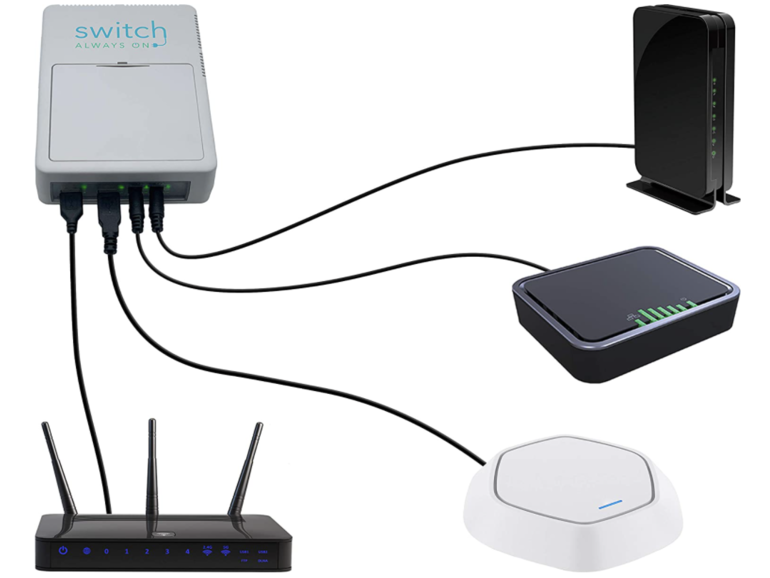If you work in a home office or have a small business with multiple remote locations, you’ve probably encountered scenarios when a power disruption or a system fault at the provider occurs, and then internet connectivity at that location is temporarily severed. It might require rebooting multiple network devices to restore connectivity even if power has been supplied continuously with a UPS.
A typical Switch Always On deployment scenario with a broadband gateway, cellular modem, and wireless access points.
Jason Perlow/ZDNet
In cases like this, human intervention is needed. Someone has to unplug a gateway device, such as a broadband/Wi-Fi router, a cable modem, or other broadband access devices like optical network terminal (ONT), and potentially access points and switches. In many cases, it may even be a sequence in which this has to be done — such as the cable modem or ONT booting up first before the gateway device.
In a home-based or small office environment, where there is someone available to perform the restart, this is an annoying and inconvenient task to accomplish. In other cases, where nobody is onsite to access the equipment, such as in a multi-dwelling unit, it could result in a significant delay before someone can perform the needed task of unplugging and re-plugging the equipment in the desired sequence.
Enter Switch Always On


Switch Always On device view displaying network and power connectivity
Jason Perlow/ZDNet
Switch Always On, made by Orlando-based Smart Charging Technologies, has designed a device to alleviate this human intervention issue with broadband device reboots once and for all: A smart UPS with integrated Wi-Fi and Ethernet device-monitoring designed specifically for 12V and 5V network devices (MSRP $200.00)
Setup is simple. The Switch Always On is plugged into AC power, and the Ethernet port on the device is then connected to a spare port on your Ethernet switch or broadband gateway. Your broadband gateway and broadband access devices are plugged directly into the Switch Always On 12V ports using supplied 12V cables and adapter connectors — the original power supply bricks are no longer used. Two Additional USB-A ports with 5V power supplies are included, and USB-A to 5V cables are also available for lower-power devices, should you need to attach and monitor them as well.
Once all of the equipment is powered, the device is configured using a smartphone app that runs on iOS and Android. This entails configuring its Wi-Fi network to monitor the local access points and their internet connectivity and its direct Ethernet connection to the broadband gateway.
We felt the setup and registration of the Switch Always On using its free cloud monitoring service was fairly easy. It only took about 10 minutes of using the app to program the device to connect to my networks and set the restart profiles for device reboots.
The app shows the current connectivity status of all your Switch Always On devices and the power supplied to all connected 12V and 5V network equipment. Still, the user interface could probably use some additional work, as it requires multiple layers of clicks to get to some frequently accessed areas — the network log for each device is buried several levels deep and it would be good if they moved that to a higher-level menu, for example.
The Switch Always On has a built-in battery that will continuously power connected equipment for up to 90 minutes. However, if the device detects any internet connectivity loss from either the Wi-Fi or Ethernet networks, it can be programmed (based on an Ethernet or Wi-Fi restart profile) to automatically reboot them in intervals of your choosing (I set mine for 10 minutes) until connectivity is restored.


Ethernet restart profiles set within my Switch Always On. The Optical Network Terminal (ONT) reboots before the Residential Gateway (RG).
Jason Perlow/ZDNet
Obviously, this will not work in the event of a total local infrastructure failure or complete loss of service at the telecom provider, in which case, having the power supplied to the broadband devices won’t actually restore connectivity. However, in areas where frequent brownouts do occur, such as in the part of South Florida that I currently live in, this is a good way of maintaining critical business connectivity.
Currently, this product is only designed to power and restart 12V and 5V connected devices, not larger 120V network devices such as smart switches (which may, in turn, be connected via PoE to Wi-Fi access points) or a bank of IoT equipment connected to a power strip. The company is currently investigating the possibility of designing a 5V-connected smart plug that could then be used to recycle power on an entire surge suppressor strip. To continually power several 120V devices, I would recommend a 750W or 1500W UPS.



